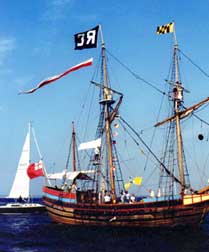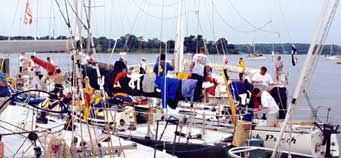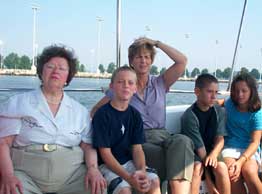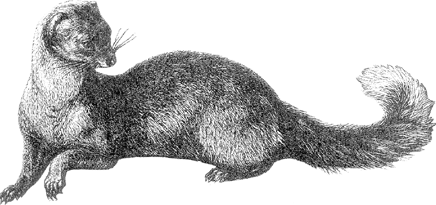|
|
 For Governor’s Cup, Full-Out Sailing Under a Full Moon For Governor’s Cup, Full-Out Sailing Under a Full Moon
photos by Marc Apter
A full moon shone on the full-out 28th annual St. Mary’s College of Maryland Governor’s Cup Yacht Race the night of August 3-4. At 70 nautical miles, this prestigious race from Annapolis to St. Mary’s is the longest overnight race on Chesapeake Bay.
With sails full of wind and sailors full of hope and spirit - plus some just full of themselves - it was a fast start at the line. “It was blowing like stink out there,” more than one sailor would note.
With gusts up to 24 knots until the wee morning hours, the three- to four-foot chop made for fast rides in well-heeled boats. The press boat - outfitted with three 200-horsepower engines christened Mona, Rosa and Sophia by Captain John Marino - was full-speed ahead to keep up with some of the sleeker sailboats.
 The winds were so heavy it was hard to hear the starting cannon from the race committee crew aboard the Maryland Dove, St. Mary’s City’s replica of that historic 17th-century square-rigger. Billows of smoke, curling up to the sailors in the crow’s nests, ensured each of the nine classes’ start. The winds were so heavy it was hard to hear the starting cannon from the race committee crew aboard the Maryland Dove, St. Mary’s City’s replica of that historic 17th-century square-rigger. Billows of smoke, curling up to the sailors in the crow’s nests, ensured each of the nine classes’ start.
“This was the first time in the 20th century that a tall ship started a yacht race,” quipped St. Mary’s College sailor-spokesman Marc Apter.
At St. Mary’s, the home of national championship sailing teams, the idea hatched for a race from Maryland’s capital in Annapolis to its first capital in St. Mary’s City. It was the 1974 brainchild of two St. Mary’s students and one alum. Since winds in August were better at night and the temperature cooler, the 47 boats that joined in the first race sailed at night and celebrated in the afternoon. This year, 157 boats registered, with 132 starting.
The record was set in 1986, with 487 competitors. Lore lays that number to a Playboy article claiming this East Coast overnighter was “one of the 10 best parties in the world.” The following year, organizers stipulated that participants in the race must know how to sail.
With the rolling seas, technical sailing and ships in the night, this race was not for the faint of heart. To keep his crew “lean and mean, hungry for a win and eager to get into port faster,” Captain David Andril of Valkyrie, which finished third in its class, starved his crew, who had come from New York, Pennsylvania, Texas, Virginia and West Virginia for the race.
 On Jean and Don Wagner’s Der Baron, heavy seas kept the family crew hungry. Breaking a 25-year tradition, this crew could not heat up their crab soup. Still Der Baron took a consolation prize. First in its class to cross the finish, it won the coveted Joseph Waldschmitt best-in-fleet trophy, which goes to the winner of the race’s most competitive class. On Jean and Don Wagner’s Der Baron, heavy seas kept the family crew hungry. Breaking a 25-year tradition, this crew could not heat up their crab soup. Still Der Baron took a consolation prize. First in its class to cross the finish, it won the coveted Joseph Waldschmitt best-in-fleet trophy, which goes to the winner of the race’s most competitive class.
Upon crossing the finish, all boats received a horn blast from the race committee. The lead boat usually hears a gunshot, signaling they led their class. Crossing the line in the mix of boats and darkness, Der Baron got only a belatedly yelled “Bang!” from a committee boat scrambling to see the winner.
Another winner reported that “it gets technical out there. The charts would read 20 feet and then one foot in a very short space. We would be on one tack for maybe 20 seconds. Then, we lost wind coming into the river and had to quickly jibe six or seven times,” said Michael Brennan, the South African-born skipper of the overall winner Sjambok. “Between that and the chop, I have bruises on my bum.”
Jim Muldoon, skipper of the 72-foot Donnybrook, agreed, “It was a lumpy night, and that moon was a killer. It was like a movie set out there.” One of the original competitors, Muldoon has sailed in every race but two. Hitting speeds of 18 knots and averaging 14, Donnybrook crossed the finish line 45 minutes ahead of Sjambok at 4:09am. But the 24-foot smaller Sjambok claimed an 11-minute victory.
The night was full of surprises for sailors with their sights set on rounding the bend into the Potomac River. Sailors recounted that all they could see in the beams of the full moon was a huge dark object looming ahead and swaying back and forth 1,000 feet in each direction across the horizon. “It had one tiny light on the back that looked like a guy with a lit cigarette,” related one racer.
Unsure of what they were seeing, they used radio to get a ship pilot’s confirmation that he was towing another ship some 800 feet long. It was hard to control in the heavy winds and high seas, he said - plus he had a blasted sailboat race bearing down behind him.
By midday on Saturday, 66 boats were still sailing. With that day’s light winds of about three knots, it took some racers over 20 hours to finish. Usual finish times range between 10 and 20 hours. Muldoon claims the fastest time in race history at six hours and nine minutes.
With crews from all over the globe, all levels of experience and all walks of life, the race was a melting pot of men and women. The waterfront at St. Mary’s college was also a mixture of sailors, tourists and townspeople come to enjoy the full-blown festivities. Bands played reggae, calypso and rock under the fest tent while giant grills ran all day and into the evening to feed the crowds.
“One of the 10 best parties in the world” may be overstated, but not much.
- Gail Howerton
 Freedom’ Fighters Sock Annapolis Freedom’ Fighters Sock Annapolis
photo by Jennifer Dawicki
The Washington Freedom, one of the Women’s United Soccer Association eight charter teams, comes to Annapolis for the last regular game of its inaugural season. The 23 women - among them 13 National Team players - take on the New York Power at historic Navy-Marine Corps Memorial Stadium Saturday, August 11. The game writes another chapter in the history book for Annapolis, host to Olympic soccer and U.S. national team action, and opens a new volume in the history of soccer. Women are the heroes of this volume.
“Look at Fortune 500 companies. Eighty percent of the women executives played sports. Sports teach lessons that are valuable in life,” Mia Hamm, star striker for the Freedom, told Diane Rehm on National Public Radio. Women’s professional soccer kicked open the door for over 200 players and coaches, making new opportunity for men as well as women.
As well as Olympian Hamm - who holds the all-time international scoring record for men and women- and her National Team sister Michelle French, Washington Freedom hired local booter Jim Gabarra as its head coach. Gabarra, the first coach hired in the league, has a history book of his own. Gabarra played on the 1998 U.S. Olympic and U.S. National teams. His wife, Hall of Famer Carin Gabarra, coaches the U.S. Naval Academy Women’s soccer team, drawing from her 1991 World Cup MVP and gold medal on the 1996 Olympic team.
Freedom’s Gabarra kicks around with soccer greats Hamm and French and the rest of the team, but he bears the burden of mixing the line-up for optimum team chemistry. Still with a record of 6–11–3 record, the Freedom will not make the playoffs this year. “I hate it,” he said of the team’s record. “I know we are better then that.”
French attributes the pumped-up club’s losing season to “breakdown of communication.” A young defense needs time to get to know one another, she said. The high expectations of crowds that topped projections - regularly reaching 8,000, all of them rooting for a superstar - also puts the young team in a pressure cooker.
No matter the record, French told Bay Weekly, “I am always concentrating on staying healthy and giving it my all.”
Of her full-time employment in the game she loves, “A little bit of luck and a push from the right people got me here,” said French.
Full-time employment with Freedom brings health benefits that include running up to five miles a match. Her salary comes from a $40-million kitty that, in April of 2000, helped the league get off the gorund. Without even a cleat mark on the pitch, “Hyundai and Johnson & Johnson signed on for millions of dollars,” said Shaun May, spokesman for the Women’s United Soccer Association.
Millions of dollars are what it usually takes to pay professional athletes. Here, the salary scale ranges, May said, “between $40,000 to a high end of $85,000. We know that players could make more on the open market.”
But to make this league work, each of the 20 founding players, all of whom were members of the ’99 World Cup Team, have been given a percentage of the league.
“We do not want to outprice ourselves,” said Hamm. “Hopefully five or 10 years from now, the salaries will grow with the fan base and television coverage.”
In anticipation of the final game in Annapolis, the fan base is seeping through the cracks in the door at RFK Stadium, in Washington, D.C., where Freedom makes its home. Michelle and Caroline Kew of Chantilly, Virginia, waited at the doors to greet Freedom players. These junior players donned Freedom shirts and stuffed soccer balls to be saturated with an indelible marker. “The players are so nice,” said Maria Kew,
Michelle and Caroline’s mother. “It is so exciting for my girls to get to meet them.”
See for yourself. The Washington Freedom defends its 2–0 winning streak against the New York Power, home to U.S. national team member Tiffeny Milbrett, in its last regular season game of the Women’s United Soccer Association inaugural season.
Fans dressed in red, white and blue will receive a free Washington Freedom pennant. Noon @ historic Navy-Marine Corp. Memorial Stadium, Annapolis. $8-22 @ Ticketmaster: 202/432-7328.
- Jennifer Dawicki
 Bigwigs Drop Big Bucks into the Bay Bigwigs Drop Big Bucks into the Bay
Sen. Barbara Mikulski, left, and EPA Administrator Christine Todd Whitman with Jeffrey Marsh, Sean Barnes and Rebecca Edmiston, all of St. Jane Frances Church in Pasadena, commemorate $1.5 million for Chesapeake Bay.
photo by Rachel Presa
Sen. Barbara Mikulski lost her first boyfriend to the Bay. “I spent my childhood summers on Stoney Creek,” she told six young members of Pasadena’s St. Jane Frances Parish during an August 7 spin around Spa Creek. “I used to catch sunfish and cut off the heads to catch crabs with. I lost my first boyfriend because he couldn’t stand to see a girl playing with worms and fish heads.”
If we’re not careful, warned Mikulski, who was joined on board by Environmental Protection Agency Administrator Christine Todd Whitman, we could end up losing the Bay itself.
Preserving the Bay launched the Quatro Water Taxi this high summer day, as Mikulski and Whitman joined National Fish and Wildlife Director John Berry to bestow $1.5 million in grants on community organizations.
The money is part of EPA’s $20.7 million Chesapeake Bay budget this year. Mikulski helped rescue the Bay budget from President George W. Bush’s threat of a 10 percent cut.
Fifty-nine local projects, at work to benefit the Bay and its watershed, share the $1.5 million in Small Watershed Grants. “There are so many groups that want to help the Bay,” said Whitman. “We received 300 proposals for this funding.”
The five winners that took home big checks this August day exemplify the “variety of great ideas” Whitman praised.
With $44,000, the Anacostia Watershed Society will teach hundreds of students about the watershed and the Bay. The students will get to work restoring habitat, monitoring water quality and touring rivers.
With $20,300, the Chesapeake Wildlife Heritage will join with Eastern Shore farmers to implement environmentally friendly management practices.
With $30,000, Virginia’s Elizabeth River Project will invest in innovative demonstration projects like forest buffers at local businesses near the river.
With $20,000, the Alliance for the Chesapeake Bay will teach citizens about the river on the annual Susquehanna Sojourn canoe and kayak trip next summer.
A very local organization got some unexpected attention. Charlotte Smutko of the South County Exchange was taken by surprise when Berry called her to the stand.
“We knew we were getting the money, but we didn’t know we would be featured today,” explained Joan Turek, chair of the organization.
South County Exchange will concentrate $25,000 in the Patuxent River Greenways project to preserve public and private lands along that river.
As well as throwing money into the Bay, Mikulski championed the EPA, advocating Whitman’s rise into the president’s cabinet.
“This time next year, I hope I’ll be sitting next to Secretary Whitman instead of Administrator Whitman,” she said.
Boyfriend or no boyfriend, Mikulski misses her childhood Bay summers. She wonders if her young companions will ever see the Bay as she saw it. “Over the summers, I watched the water change, get darker, with less crabs and fish. When we’ve accomplished all we hope to, this Bay is going to glisten.”
- Rachel Presa
Way Downstream ...
In Grasonville, a one-mile marked canoe trail has been opened at Horsehead Wetlands Center along with an observation tower and a new boardwalk. You can even rent a canoe for $10 and purchase a family membership for $50 in the pristine center, which is just the other side of the Bay Bridge …
In Virginia, officials finally may be getting the point about preservation. State and federal officials last week announced an agreement to spend $1.5 million for easements that will prohibit development of 1,431 acres along the Potomac River. It is just the second time that private lands in Virginia have been declared a natural area preserve …
In Delaware, plant biologists say the state’s wetlands are being overrun with an invasive species: purple loosestrife. While its violet blooms may look appealing in summer, the invader threatens fragile marsh and stream habitat by muscling out native plants …
In Paris, Greens symbolically renamed the highway that runs along the River Seine “Velorution Quay” - a play on the world revolution using the word “velo,” French for bicycle. Officially, the 2.5-mile road is named after former French President Georges Pompidou. They also renamed a bridge “Le Pont des Poissons qui Chantent.” Translation: “The Bridge of the Singing Fish” …
Our Creature Feature comes from Spain, where authorities may be examining the coats of townspeople in La Puebla de Valverde. That’s because more than 10,000 mink escaped from a fur farm last week after an attack presumably by animal  rights advocates. rights advocates.
Police and villagers wielding nets were chasing the slim creatures with the luxurious fur with mixed success. But many already had gone into hiding, and there were fears that beyond financial losses, the hungry carnivores would be devouring all the rabbits and the partridge in the countryside.Spain, where authorities may be examining the coats of townspeople in La Puebla de Valverde. That’s because more than 10,000 mink escaped from a fur farm last week after an attack presumably by animal rights advocates.&Police and villagers wielding nets were chasing the slim creatures with the luxurious fur with mixed success. But many already had gone into hiding, and there were fears that beyond financial losses, the hungry carnivores would be devouring all the rabbits and the partridge in the countryside.ores would be devouring all the rabbits and the partridge in the countryside.Spain, where authorities may be examining the coats of townspeople in La Puebla de Valverde. That’s because more than 10,000 mink escaped from a fur farm last week after an attack presumably by animal rights advocates.&Police and villagers wielding nets were chasing the slim creatures with the luxurious fur with mixed success. But many already had gone into hiding, and there were fears that beyond financial losses, the hungry carnivores would be devouring all the rabbits and the partridge in the countryside.
Copyright 2001
Bay Weekly
|